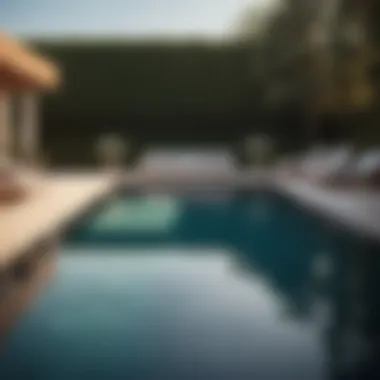Mastering the Art of Setting Up Your Own Pool: A Comprehensive Guide for Pool Enthusiasts


Materials:
-
Pool kit: Opt for a high-quality pool kit that includes all necessary components for setup, such as liner, pump, filter, and ladder. Ensure the dimensions match your desired pool size for a seamless installation process. Quantities may vary depending on pool size.
-
Ground Cloth: A durable ground cloth provides a protective barrier between the pool liner and the ground, preventing punctures and extending the lifespan of your pool. Measure the area to place the ground cloth accurately.
-
Sand or Sand Base: Prepare a leveled sand base to provide stability and support for the pool structure. Calculate the required amount based on your pool's dimensions for proper installation.
-
Pool Chemicals: Stock up on essential pool chemicals like chlorine, pH balancers, and algaecides to maintain water quality and sanitation. Follow manufacturer instructions for proper usage.
-
Tools: Gather tools such as a shovel, tape measure, screwdriver, and level for efficient assembly. Having the right tools on hand can streamline the installation process and ensure accurate results.
DIY Steps:
-
Site Selection: Choose a flat, level area in your backyard for pool placement, ensuring no overhead obstructions. Mark the pool's perimeter dimensions with chalk or spray paint.
-
Ground Preparation: Clear the area of any debris or potential hazards. Place the ground cloth and spread a uniform layer of sand to create a stable base for the pool.
-
Pool Assembly: Follow the manufacturer's instructions to assemble the pool frame, connect the pump and filter system, and secure the liner in place. Check each step carefully to avoid errors.
-
Filling the Pool: Fill the pool with water, allowing the liner to adjust and settle into place. Monitor the water level to prevent overfilling and ensure proper balance.
Technical Aspects:
-
Timing: Allocate sufficient time for each stage of the setup, from ground preparation to filling the pool. Consider factors like weather conditions and daylight for optimal progress.
-
Critical Techniques: Properly leveling the ground, securing the liner without wrinkles, and maintaining water chemistry are crucial techniques to achieve a flawless pool setup. Follow best practices for lasting results.
-
Tools: Utilize tools like a pressure gauge for the pump, testing kits for water quality analysis, and a pool vacuum for maintenance tasks. Having the right tools can simplify upkeep and troubleshooting.
DIY Project Process:


-
Sequential Steps: Execute each step in chronological order, starting from site selection to pool filling. Maintain a systematic approach to avoid mistakes and ensure a smooth installation process.
-
Troubleshooting Tips: Address common issues like leaks, water imbalance, or equipment malfunctions promptly. Refer to the manufacturer's guide or seek professional assistance if needed for efficient problem-solving.
Planning Your Pool Installation


Setting up a pool is no small task; it requires meticulous planning to ensure that every aspect is considered and executed properly. Planning your pool installation is crucial to the success of the entire project. By carefully outlining the steps involved, from choosing the right pool type to setting a budget and timeline, you are setting yourself up for a smooth and enjoyable experience.
Choosing the Right Pool Type
When it comes to selecting the right pool type for your space, several factors need to be taken into account. Whether you opt for an in-ground pool, above-ground pool, or a portable pool, each type has its own unique characteristics and considerations.
In-ground Pools
In-ground pools are a popular choice for their durability and overall luxurious feel. Their key characteristic lies in their permanent structure that integrates seamlessly into the surrounding landscape. The advantage of in-ground pools is their customization options, allowing you to design a bespoke pool that meets your specific needs. However, the downside may be the higher upfront cost compared to other pool types.
Above-ground Pools
On the other hand, above-ground pools offer a more budget-friendly option with easy installation and relocation features. Their key characteristic is their temporary nature, making them ideal for those who may not want a permanent pool structure. Above-ground pools are popular for their affordability and quick setup, but they may lack the visual appeal and long-term durability of in-ground pools.
Portable Pools
Portable pools provide flexibility and convenience for homeowners looking for a temporary pool solution. Their key characteristic is their portability, allowing them to be set up and moved as needed. Portable pools are beneficial for those who want a cost-effective and versatile pool option. However, they may have limitations in size and depth compared to in-ground and above-ground pools.
Determining Pool Size and Location
Once you have selected the type of pool that suits your preferences, the next step is to determine the ideal size and location for installation. Assessing the available space, considering sunlight exposure, and checking local regulations are essential aspects to consider.
Assessing Available Space
Assessing the available space for your pool involves evaluating the dimensions and layout of your backyard. The key characteristic of this step is to ensure that the pool fits comfortably within the designated area without overcrowding the space. By considering factors such as landscaping, walkways, and other outdoor amenities, you can optimize the layout for both functional and aesthetic purposes.
Considering Sunlight Exposure
Sunlight exposure plays a crucial role in the placement of your pool. The key characteristic of this consideration is to position the pool in an area that receives adequate sunlight throughout the day. This not only helps maintain optimal water temperature but also enhances the overall swimming experience. By strategically choosing a location with proper sunlight exposure, you can create a more inviting and enjoyable pool environment.
Checking Local Regulations
Before proceeding with your pool installation, it is essential to check local regulations regarding pool construction. The key characteristic of this step is to ensure compliance with zoning laws, safety requirements, and permit regulations in your area. By familiarizing yourself with the necessary permits and guidelines, you can avoid potential legal issues and ensure a smooth approval process for your pool project.
Setting a Budget and Timeline
Setting a realistic budget and timeline for your pool installation is essential for managing costs and completion schedules effectively. Considering factors such as the cost of pool materials, labor expenses, and the timeline for completion can help you establish a comprehensive plan for the project.
Cost of Pool Materials
The cost of pool materials encompasses everything from the pool shell to the filtration system and other accessories. The key characteristic of this aspect is to allocate funds for high-quality materials that align with your design preferences and durability requirements. While investing in top-notch materials may increase initial costs, it can save you money in the long run by reducing maintenance and repair expenses.
Labor Expenses
Labor expenses include the costs associated with hiring professionals to install your pool. The key characteristic of this aspect is to budget for skilled labor that guarantees a seamless and efficient installation process. While labor costs can vary based on the complexity of the project and the experience of the workers, prioritizing quality craftsmanship is essential for ensuring the longevity and functionality of your pool.
Timeline for Completion
Establishing a realistic timeline for completing your pool installation is crucial for avoiding delays and staying on track with the project. The key characteristic of this timeline is to allocate sufficient time for each phase of the installation process, from excavation to finishing touches. By setting milestones and deadlines, you can monitor progress efficiently and adjust the schedule as needed to ensure timely completion of your pool.
Preparation and Site Readiness


Preparation and site readiness are pivotal aspects in the successful installation of a pool. It sets the foundation for a smooth and efficient process, ensuring that all necessary steps are taken before proceeding with the construction. By focusing on preparation and site readiness, homeowners can avoid potential setbacks and complications that may arise during the pool installation phase. This section delves into the critical elements that housewives and homeowners need to consider to ensure their pool project runs seamlessly.
Obtaining Necessary Permits
When it comes to obtaining necessary permits, it is crucial to adhere to local regulations and guidelines. Local construction permits play a significant role in ensuring that the pool installation meets all required standards and safety protocols. By obtaining the proper permits, homeowners can proceed with their pool installation confidently, knowing that they are compliant with local laws and regulations. This process helps prevent issues that may arise later due to non-compliance.
Utility line checks are another essential aspect of preparation and site readiness. Conducting thorough utility line checks ensures that the pool installation area is clear of any potential hazards or obstructions. By verifying the location of utility lines, homeowners can prevent any damage that may occur during the construction process. This step is crucial in maintaining the safety and integrity of the property throughout the pool installation.
Clearing the Installation Area
Clearing the installation area involves removing debris and leveling the ground to create a suitable foundation for the pool. Removing debris is essential to ensure that the construction site is clean and free of any obstacles that may hinder the installation process. By clearing the area, homeowners can create a safe and conducive environment for the pool construction team to work efficiently.
Leveling the ground is a critical step in preparing the installation site. It ensures that the pool's foundation is stable and even, preventing any issues that may arise due to uneven terrain. By leveling the ground properly, homeowners can avoid future complications such as pool shifting or damage.
Ensuring Proper Drainage
Proper drainage is vital to maintain the integrity of the pool and surrounding area. Grading the site helps in directing water away from the pool, preventing water accumulation and potential damage. By ensuring proper grading, homeowners can safeguard their pool investment and property from water-related issues.
Installing drainage systems further enhances the drainage capabilities of the pool area. These systems help manage excess water efficiently, reducing the risk of flooding or structural damage. By incorporating effective drainage systems, homeowners can prolong the lifespan of their pool and ensure a safe environment for their family and guests.
Pool Installation Process
In the realm of setting up a pool, the pool installation process stands as a pivotal stage where the dream of owning a personal oasis starts to materialize. This section of our comprehensive guide plays a crucial role in delineating the detailed steps and considerations, ensuring a seamless transition from planning to the actual creation of your aquatic haven.
Assembling Pool Components
When it comes to assembling pool components, precision and quality are key factors that cannot be overlooked. Each component plays a significant role in the overall functionality and aesthetics of the pool. Let's delve into the specific aspects of installing walls and frame, attaching liner, and adding a filtration system.
Installing Walls and Frame
The installation of walls and frames is the foundational element of constructing an enduring and structurally sound pool. The choice of materials for the walls and frame is critical, as it directly impacts the longevity and sturdiness of the pool. Opting for high-quality materials like reinforced steel or durable composite materials ensures resilience against the elements and provides a sturdy framework for the pool structure. The precision in aligning and securing the walls and frame is essential to prevent any potential leakage or structural weaknesses that could compromise the integrity of the pool.
Attaching Liner
The liner plays a dual role in enhancing the aesthetic appeal of the pool and safeguarding it against wear and tear. Choosing a liner that complements the overall design scheme while being robust and resistant to punctures is essential. The attachment of the liner requires meticulous attention to detail to ensure a snug fit that prevents wrinkles or air pockets. A properly installed liner not only contributes to the visual appeal of the pool but also extends its lifespan by providing a protective barrier against the water and chemicals within.
Adding Filtration System
A filtration system is the unsung hero of pool maintenance, working tirelessly to keep the water crystal clear and safe for swimming. Selecting an efficient filtration system tailored to the size and usage frequency of your pool is crucial. Whether opting for a sand, cartridge, or diatomaceous earth filtration system, each has its unique benefits in terms of cost-effectiveness, ease of maintenance, and filtration capacity. The filtration system ensures that debris, contaminants, and impurities are effectively removed, offering a hygienic and enjoyable swimming experience for the pool owners.
Filling and Testing the Pool
One of the most anticipated moments in the pool installation process is the filling and testing phase, where the pool finally takes shape as a water-filled sanctuary awaiting its first dip. This phase involves meticulous attention to detail and a rigorous testing regime to guarantee the pool's functionality and safety.
Filling Pool with Water
The act of filling the pool with water signifies a significant milestone in the pool installation journey, transforming an empty basin into a shimmering pool of possibilities. The water source chosen for filling the pool, whether from a municipal water supply or a natural source, should meet specific quality standards to prevent any potential issues like algae growth or mineral imbalances. The rate of filling the pool should be controlled to ensure the even distribution of water and minimize any stress on the pool structure.
Balancing Chemicals
Achieving the perfect chemical balance in the pool water is paramount for maintaining water clarity, preventing algae growth, and ensuring the safety of swimmers. Testing the water for pH levels, chlorine concentration, and other chemical parameters is essential to determine the appropriate chemical adjustments needed for a healthy swimming environment. Balancing chemicals not only enhances water quality but also prolongs the lifespan of the pool equipment and elements by preventing corrosion or scale buildup.
Checking for Leaks
A meticulous inspection for leaks is a crucial step in ensuring the structural integrity of the pool and preventing water loss or damage. Utilizing specialized equipment like leak detection dyes or pressure testing systems helps pinpoint any potential leaks in the pool structure or plumbing. Identifying and promptly addressing leaks not only conserves water but also saves costs on extensive repairs or water damage mitigation efforts.
Finalizing Pool Surroundings
As the pool installation nears completion, attention shifts towards finalizing the pool surroundings to create a cohesive and inviting outdoor oasis that complements the pool's aesthetics and functionality.
Decking Options
Decking options play a vital role in enhancing the usability and visual appeal of the pool area, offering a safe and stylish space for lounging, sunbathing, or entertaining. Materials like composite wood, natural stone, or concrete pavers provide versatile options for decking that blend seamlessly with the pool design. The choice of decking material should consider factors like slip resistance, heat retention, and durability to ensure years of enjoyment without compromising on safety or aesthetics.
Landscaping Considerations
Landscaping considerations add the finishing touches to the pool environment, transforming it into a tranquil retreat that harmonizes with its natural surroundings. Incorporating lush greenery, colorful blooms, and strategic hardscaping elements enhances the visual appeal and privacy of the pool area. Attention to factors like irrigation, drainage, and maintenance requirements ensures that the landscaping not only looks stunning but also thrives in the outdoor setting, creating a sustainable and inviting ambiance around the pool.
Maintenance and Care Tips
Maintaining and caring for your pool is essential to ensure its longevity and your enjoyment. In this comprehensive guide on setting up a pool, we delve into the significance of proper maintenance and care, highlighting key elements, benefits, and considerations that are crucial for every pool owner.
Regular Cleaning and Filtration
Skimming the Surface
Skimming the surface of your pool is a fundamental aspect of regular cleaning and filtration. By skimming debris, leaves, and other particles off the water's surface, you prevent clogging of the filtration system, maintaining water clarity and hygiene. The key characteristic of skimming is its ability to quickly remove visible contaminants, helping preserve the pool's aesthetics and cleanliness. This practice is a popular choice for pool maintenance as it is efficient and straightforward, ensuring that your pool water remains pristine. The unique feature of skimming is its immediate impact on the pool's appearance and functionality, making it a necessary step in your pool care routine.
Vacuuming the Pool
Vacuuming the pool complements skimming by cleaning debris that has sunk to the bottom. This process contributes significantly to overall cleaning and filtration efforts, ensuring thorough cleanliness and preventing algae growth. The key characteristic of vacuuming is its ability to reach debris that the skimming process may miss, providing a comprehensive cleaning solution. Vacuuming is a popular choice for maintaining pool hygiene and clarity, especially in areas where debris accumulation is common. The unique feature of vacuuming is its effectiveness in removing particles from the pool floor, enhancing water quality and appearance while promoting a healthier swimming environment.
Monitoring Chemical Levels
Testing and Adjusting p
H
Testing and adjusting the pH level of your pool water is crucial for proper chemical balance and swimmer comfort. Monitoring pH levels regularly helps prevent equipment corrosion, eye and skin irritation, and ineffective sanitizer performance. The key characteristic of testing and adjusting pH is its role in optimizing water quality, ensuring a safe and enjoyable swimming experience for users. This practice is a popular choice for maintaining pool chemistry as it directly impacts water balance and sanitizer efficiency. The unique feature of testing and adjusting pH is its ability to prevent issues associated with imbalanced water, promoting a balanced and healthy aquatic environment.
Chlorine Levels Maintenance
Maintaining appropriate chlorine levels in your pool is essential for disinfection and algae prevention. Consistent monitoring and adjustment of chlorine levels keep the water safe, clean, and free from harmful bacteria. The key characteristic of chlorine levels maintenance is its effectiveness in eliminating contaminants and pathogens, safeguarding swimmers' health and well-being. This practice is a popular choice among pool owners as it is a fundamental aspect of water sanitation. The unique feature of chlorine levels maintenance is its ability to provide continuous protection against microbial contaminants, ensuring that your pool water remains safe and inviting.
Winterizing and Off-season Maintenance
Draining and Covering the Pool
Draining and covering your pool before winter is vital to protect it from damage caused by freezing temperatures and debris accumulation. Proper drainage prevents water freezing and expanding, which can lead to cracks in the pool structure. The key characteristic of draining and covering is its ability to shield the pool from environmental factors that could compromise its integrity. This practice is a popular choice for winterizing pools as it extends the lifespan of the pool and reduces maintenance costs. The unique feature of draining and covering the pool is its capacity to preserve water quality and structural integrity during the off-season, ensuring a smooth reopening in the spring.
Equipment Storage
Properly storing pool equipment during the off-season is essential to prevent damage and prolong its lifespan. Organizing and storing items such as pumps, filters, and hoses in a dry and secure location shields them from environmental elements and corrosion. The key characteristic of equipment storage is its role in maintaining equipment functionality and efficiency, preserving their performance for the next season. This practice is a popular choice for ensuring equipment longevity and reliability, reducing the need for premature replacements. The unique feature of equipment storage is its ability to protect valuable pool assets, minimizing maintenance expenses and enhancing overall pool operational efficiency.



